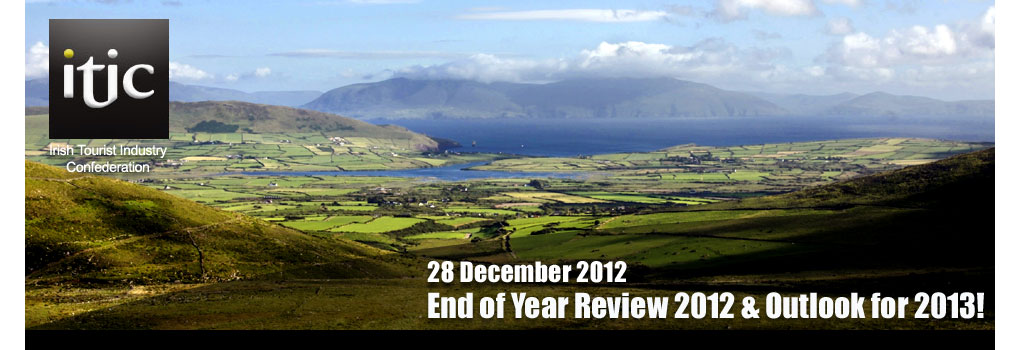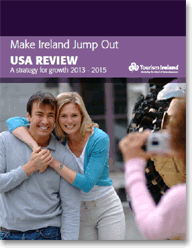
About 6.5 million overseas arrivals in 2012 showed little or no growth on 2011. The year turned out to be a mixed bag, with arrivals from most main markets showing modest increases, while recovery from Britain yet again proved elusive. Businesses in Dublin and some top tourism honey spots had a good year, in contrast to other parts of the country which welcomed fewer visitors.
A 2% increase in arrivals from mainland Europe and a similar level of increase from North America, was not sufficient to compensate for the 4% drop, or approximately 100,000 fewer visitors, from Britain.
The good news is that a modest recovery seems to be underway from some traditional and newer developing source markets beyond Britain. Despite the economic crisis across Europe, the overall number of arrivals from the Continent increased to almost 2.4 million, with high single digit percentage growth from Germany. North America had a good performance, despite a very soft July, but with a strong latter half of the year it edged past the 1 million visitor levels, and close to the peak performance delivered in 2007. Arrivals from the rest of the world produced over 350,000 visitors, or 5% of total, with almost half of these coming from Australia and New Zealand.
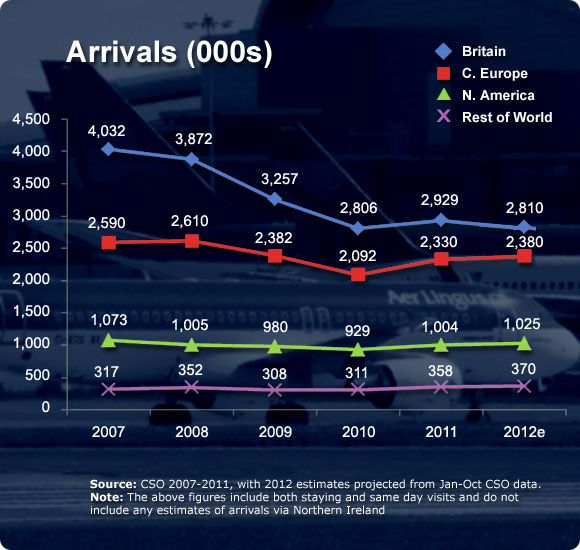

The monthly arrivals pattern throughout the year was also a mixed bag. Demand in the peak summer months was disappointing, with arrivals down 7% in July and 1% in August compared to a year earlier.
The domestic market performed reasonably well given the fragile state of the economy and depressed consumer spending power. This resulted in less frequent, shorter, and lower spending trips. The poor summer weather not only affected farmers but drove many potential home holiday clients to the sun.
Dublin bounced back strongly with hotel occupancy levels approaching those achieved at the peak in 2007. Room yields also recovered but are still far short of the levels achieved at the peak. Dublin benefited from a busy calendar of high profile events, several major conferences at the CCD, a buoyant business travel demand, and the re-emergence of a good-value reputation for the city which boosted leisure demand. Other tourism hot spots, including Killarney, Galway city, Kilkenny, Cork and Westport, reported an upturn in demand over the past 12 months. Meanwhile, other areas continued to feel the chill winds of recession and saw no recovery from the downturn in visitor demand of the past few years.
The Government initiatives including the lower VAT rate for tourism services, a reduction in the Air Travel Tax and new tourist visa arrangements have helped to restore competitiveness and are welcomed by the industry.

|
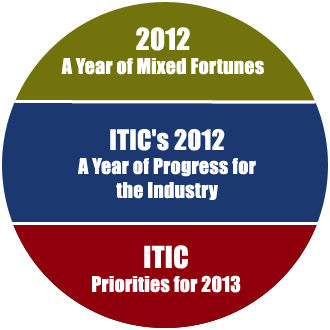
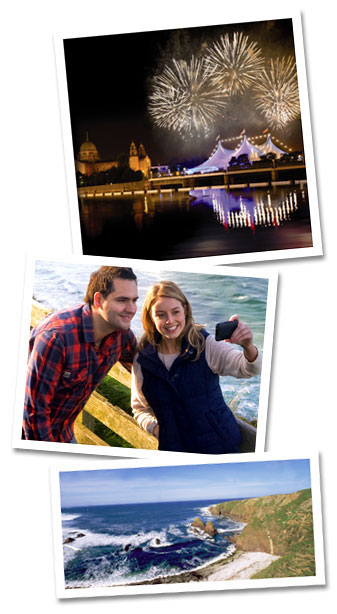
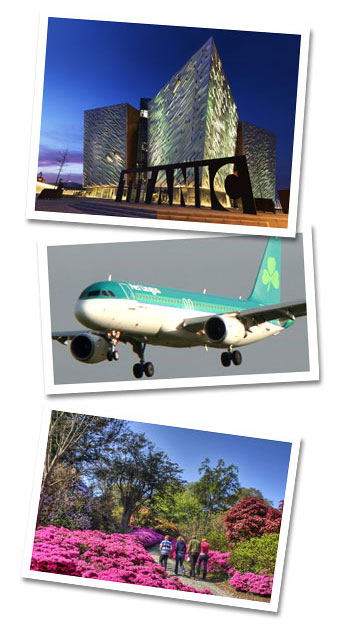
|

The past year was another busy and productive one for ITIC, working on behalf of all the businesses engaged in the tourism and hospitality trade. ITIC continued to influence policymakers and shape changes in how state agencies support the industry and market the destination. Through its representation on public sector boards and industry working groups, ITIC has influenced new strategies and operational programmes, most notably the following:
Tourism Recovery Taskforce (TRT)
This landmark initiative from ITIC in 2011 has radically reshaped the dialogue and the working relationship between the industry and the state agencies responsible for tourism. The new collaborative forum engaging with Fáilte Ireland, Tourism Ireland and the NITB has been developing strategies to address the crisis facing tourism businesses. ITIC has played a key role in shaping the work and outputs of the TRT, with the experience pointing to the need to ensure that an effective working forum continues beyond the remit of the TRT which expires at the end of 2013. |
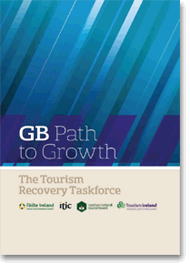
|
GB Path to Growth
The turnaround plan for the British market, the principal output of the TRT, was heavily influenced by ITIC and its members in the process of shaping the new strategy. The plan is ambitious in seeking an average annual 5% recovery rate over the next 5 years. The focus on key segments and the research driven customisation of experiences for each target group is a major shift which aims to deliver a better return on investment in the market. The plan opens up many new opportunities for businesses. The approach will see new promotional campaigns to attract three specific segments of the market - ‘Social Energisers’ (young, fun-loving urban adventurers); ‘Culturally Curious’ (over 45s who want to broaden their minds); and ‘Great Escapers’ (younger couples who want to get away from it all).
CLICK HERE for the Report (PDF format) |
US Market Review
Tourism Ireland’s recent review of prospects is upbeat with a target of delivering 20% more visitors over the next 3 years. This would see over 1 million visitors from the USA alone in 2015. ITIC participated in the drawing up of the latest strategic plan for the market and is confident that Ireland can once again win a bigger share of the US-Europe leisure demand. Research would suggest that growth of this level is very feasible, and the recently announced increases in air capacity supports that.
CLICK HERE for the Report (PDF format) |
|
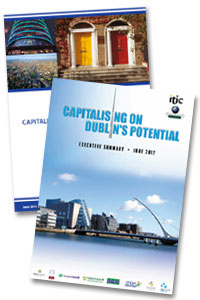
|
Capitalising on Dublin’s Potential
Tourism is big business in Dublin, with close to 4 million overseas visitors this year, generating over €1 billion spend, and supporting just over 50,000 jobs, but still short of the peak attained in 2007. ‘Capitalising on Dublin's Potential‘ a blueprint for tourism growth to 2020 was published by ITIC during the year. The report, guided by a Steering Group of stakeholders from the tourism sector, City and County Councils, and the business sector, was chaired by Maurice Pratt.
The target is to attract 6.4 million visitors to the capital city region. These additional 2.4 million visitors would have profound impact on the city region generating an estimated €1.8 billion in revenue and creating an additional 27,000 new jobs by 2020.
CLICK HERE for the Report (PDF format)
CLICK HERE for the Executive Summary (PDF format) |
New Directions for Tourism in the West
Wild Atlantic Way, a new branded and well interpreted Atlantic coast drive integrated with a series of shorter touring routes, is well underway to completion. Considerable progress has been made by Fáilte Ireland working with Local Authorities and other parties on this initiative designed to encourage more visitors to explore the scenery, culture and activities available along the western seaboard. The proposal was one of the key recommendations in ITIC’s report New Directions for Tourism in the West published in 2011.
Portmagee recently became the first ever winner of Fáilte Ireland’s National Tourism Towns Award, another recommendation from the ITIC report which has been enthusiastically implemented by Fáilte Ireland.
CLICK HERE for the Report (PDF format) |
 |
Shannon Airport
The Government’s decision to grant Shannon Airport the long-awaited freedom to determine its own future is welcome. The airport will merge with a restructured Shannon Development and form a new publicly owned commercial entity in 2013. It is planned that the new company will seek to develop an Aviation Services Centre which is projected to create and maintain 3,000-5,000 jobs within 5 years, not including construction jobs. |
It’s a challenging but exciting new era for Shannon, and a direction which has long been pursued by local interests. The restructuring plan calls for ambitious traffic growth which if achieved will deliver significant benefits for the tourism industry in the region and the West. |
Our Ocean Wealth
As marine resources form a valuable component of the appeals and experiences of tourism in Ireland, ITIC made a submission to the Minister for Agriculture, Food and the Marine, on how best to harness Ireland’s ocean wealth. The consultative process is designed to shape future policy and strategies on how best to harness the potential of Ireland’s vast marine resource. ITIC argued that as an island destination the maintenance and sustainable development of the marine resources are essential to the enhancement of the Ireland brand identity and reputation abroad.
CLICK HERE for the Report (PDF format) |
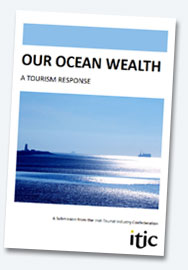 |
Advocacy on Behalf of Tourism Businesses
Over the past 12 months ITIC has been active in influencing Government on policy, regulatory and administrative issues. The submissions and briefings of Ministers and officials have ensured that a tourism perspective is considered when forming and shaping decisions. Examples of the advocacy role of ITIC included:
- Pre-Budget submission argued the capacity of tourism to play an important role in the regeneration of the national economy thanks to its labour intensive nature and regional economic impacts.
- Visa Waiver programme: ITIC strongly argued for a more permanent arrangement for common entry visa to the UK and Ireland, including more convenient and less bureaucratic processes. This is essential if Ireland is to effectively compete in a number of long haul emerging markets. The pilot programme has been extended to October 2016.
- Aviation Policy, in conjunction with IBEC, a detailed case has been made for a policy which would provide for capacity growth, competition and a benign tax regime to encourage air service development, so critical to tourism growth.

|
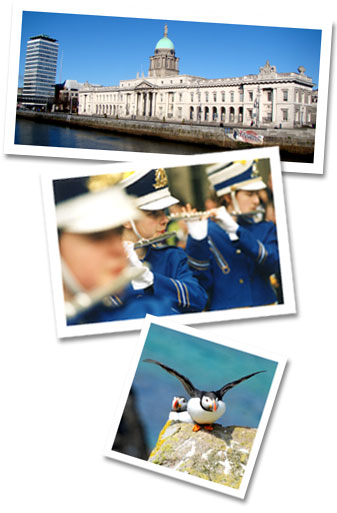
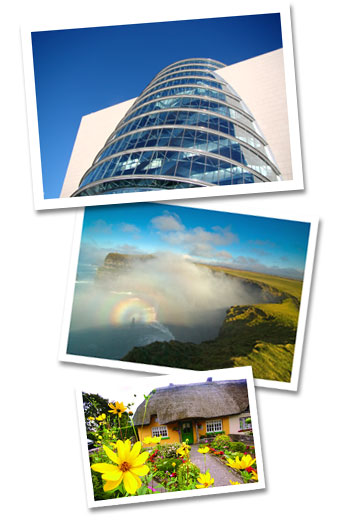
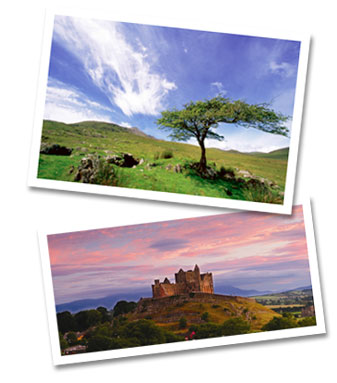

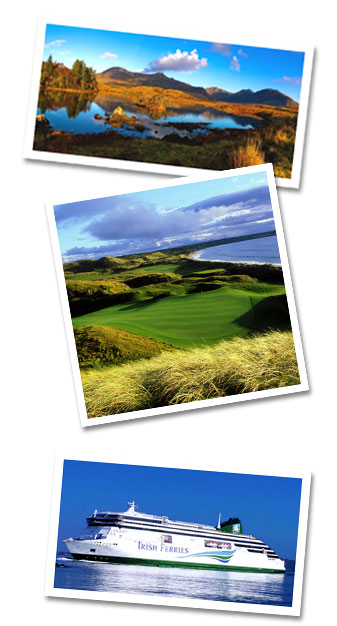
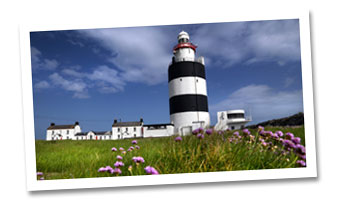
|

The top priority for 2013 is the restoration of sustainable growth for Irish tourism. The new marketing strategy for Britain, together with ambitious promotional programmes in other markets as well as the high profile year-long Gathering, have the potential to turn the fortunes of the industry. All tourism businesses are anxious to achieve success and will be working closely with Fáilte Ireland and Tourism Ireland to ensure that we generate more overseas visitors in 2013 and beyond.
Over the past five years the supply and demand scenarios in international tourism have changed with new trends and patterns continuing to evolve. In Ireland the industry continues to face the most difficult period in its history with a set of unprecedented challenges. The time is now opportune for Government, together with the industry, to re-assess national tourism policy, within the context of Ireland’s economic recovery and future growth. A new strategic plan is urgently needed to provide a framework for investment, marketing and implementation against an agreed set of targets.
Recent research has shown that there is a need to ensure a better ‘market fit’ of the holiday propositions we promote. This is particularly important in ensuring that the appeals and attractions are tailored to specific segments of the market which show the greatest potential to visit Ireland. Travel motivations and behaviour are changing with international travellers seeking more authentic and unique experiences. While Ireland has a rich natural and man-made foundation to deliver exciting and different experiences, we have not been particularly good at ‘bundling’ the attractions, or in innovating to appeal to new market segments. The emphasis must continue to focus on refreshing the attractions and presenting them in a more user appealing fashion. The excellent work on the Wild Atlantic Way is a good example of an innovative approach to developing visitor experiences which hopefully will be followed by other new and inventive developments during 2013.
The success of the Tourism Recovery Taskforce (TRT) has amply demonstrated the benefits of improved collaboration between the state agencies and the business community. ITIC will be working over the coming 12 months to ensure that an equally productive forum will succeed the TRT when its remit expires at the end of the year.

|
 |
| © ITIC | Irish Tourist Industry Confederation | Registered in Dublin | Registered No: 75658 | All Rights Reserved |
 |
 |
 |
 |
 |
|
|
